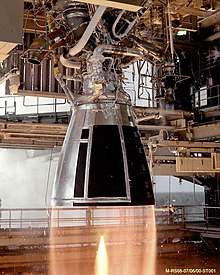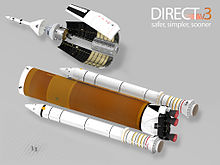DIRECT is advocated by a group of space enthusiasts that asserts it represents a broader team of dozens of NASA and space industry engineers who actively work on the proposal on an anonymous, voluntary basis in their spare time. September 2008[update], the DIRECT Team was said to consist of 69 members[1], 62 of whom were NASA engineers, NASA-contractor engineers, and managers from the Constellation Program. A small number of non-NASA members of the team publicly represent the group.
The project name "DIRECT" refers to a philosophy of maximizing the re-use of hardware and facilities already being used for the current Space Transportation System (STS) program, hence a "direct" transition. The DIRECT Team asserts that using this approach to develop and operate a family of high-commonality rockets would reduce costs and the gap between retirement of the Space Shuttle and the first launch of Orion, shorten schedules, and simplify technical requirements for future US human space efforts.
Three major versions of the DIRECT proposal have been released with the latest, Version 3.0, having been unveiled in May 2009. On 17 June 2009, the group presented its proposal at a public hearing of the Review of U.S. Human Space Flight Plans Committee, a panel reviewing US space efforts, in Washington D.C.[2]
With the October 11th signing of the NASA Authorization Act of 2010 (S. 3729) by President Obama mandating work on the Space Launch System Heavy Lift Launch Vehicle, the DIRECT Team has declared success of their effort. They have since announced the formation of a new space technology company: C-Star Aerospace, LLC.
DIRECT's Jupiter vehicle is an "in-line" Space Shuttle-derived launch vehicle. This broad category of Shuttle adaptations, postulated since before the first Shuttle launch, removes the winged Space Shuttle Orbiter, moves the liquid main engines to the bottom of the cryogenic tankage (typically proposed to be adapted from the Shuttle External Tank), and relocates the payload to above the tankage.
The first official study of the concept was conducted in 1986 by NASA's Marshall Space Flight Center in the aftermath of the Space Shuttle Challenger disaster.[10] It was promoted as one of the alternatives for launching unmanned cargo and would have potentially allowed a re-started lunar program as well. There were, however, no funds available to NASA for building any new vehicles while the Space Shuttle Program continued. The idea was shelved and NASA concentrated on fixing and operating the Space Shuttle instead.
DIRECT has a resemblance to the 1991 National Launch System effort. Proposed jointly by NASA and the Department of Defense as an alternative to the Titan IV, the design was based on the same Solid Rocket Boosters and modified External Tank, but instead of the reusable Space Shuttle Main Engine, specifed four of the proposed disposable, less expensive Space Transportation Main Engines. The United States Congress did not appropriate funding for the development. A great deal of reference material exists in the public domain regarding NLS[11][12][13][14].
NASA's Exploration Systems Architecture Study (ESAS) of 2005 included a similar design to the DIRECT proposal using three Space Shuttle Main Engines (SSME). Known as LV-24 in Crew launch form, and LV-25 in Cargo configuration, the idea was dismissed because it did not have sufficient performance for the proposed lunar program - however the concept was not considered using an Earth departure stage (EDS).
DIRECT's re-exploration of the SDLV idea began in 2006 in frustration with the high cost and delays of Ares I and worries that any similar issues with the giant Ares V might put the whole Constellation Program in jeopardy. An additional goal was to maintain American ability to launch crews to space with as short a gap as possible after the planned retirement of Shuttle.
[edit] DIRECT v1.0
According to the DIRECT team, the first version of the DIRECT proposal was the product of a three-month study produced by more than a dozen NASA engineers and managers working in their free time, and a small group of engineers and non-engineers outside of NASA. DIRECT took the final ESAS recommendation of using the EDS during the ascent phase of the flight to gain additional launch performance on the Cargo LV, and applied this same methodology to the LV-24/25.The next change in DIRECT's development was in response to NASA dropping the Space Shuttle Main Engine on the Ares V design due to the high manufacturing cost of the SSME engines and the difficulty in producing the required number of units per year with existing manufacturing facilities. NASA specified five RS-68 engines as the core engines for Ares V. The DIRECT proposal specified that its core should include two RS-68 engines. Additional performance for carrying payloads to Low Earth Orbit would be provided by upgrading the main engines with Regenerative Cooling Nozzles to improve their efficiency.
The v1.0 proposal was submitted on October 25, 2006 to NASA's Administrator, Michael D. Griffin, and a wide range of industry, political and advocacy groups involved in the Constellation program.
[edit] Criticism of v1.0
In late 2006, head of the ESAS Study, Dr. Doug Stanley, declared that the DIRECT v1.0 proposal could not work as it relied on overly-optimistic and speculative performance specifications for an upgraded RS-68 Regen engine. Dr. Stanley produced official specifications from Rocketdyne about the RS-68 Regen upgrades as evidence for his point.[edit] DIRECT v2.0

Direct v2.0 proposed to use a human-rated version of the existing RS-68 engine design.
According to the proposal, the single-stage Jupiter-120 could achieve low Earth orbit with two standard ablative RS-68 engines, while an extra RS-68 was required on the core stage of the heavier two-stage Jupiter-232. The Earth Departure Stage for Jupiter-232 now required two standard J-2X engines instead of one.[15]
The DIRECT Team produced a 131-page DIRECT v2.0 exploration architecture study that was released on September 19, 2007 at the AIAA "Space 2007" Conference in Long Beach, CA. According to the group, this paper was created within a 9-month study. The paper provided detail on how the launch vehicles would be one component of a wider-reaching architecture for enabling the US to maintain the ISS, fly lunar missions, and provide additional capabilities for the NASA human spaceflight program. These capabilities included missions to Mars, Lagrangian point staging architecture options, and mission architectures for visiting Near-Earth object destinations.[16].
[edit] Criticism and Rebuttal of v2.0
In June 2008, David King, director of NASA's Marshall Space Flight Center stated that NASA has considered DIRECT as well as many other rocket proposals, and that the Ares family was the right set of rockets for the mission.[17] "DIRECT v2.0 falls significantly short of the lunar lander performance requirement for exploration missions as specifically outlined in Constellation Program ground rules. The concept also overshoots the requirements for early missions to the International Space Station in the coming decade. These shortcomings would necessitate rushed development of a more expensive launch system with too little capability in the long run, and would actually increase the gap between space shuttle retirement and development of a new vehicle. Even more importantly, the Ares approach offers a much greater margin of crew safety - paramount to every mission NASA puts into space."In July 2008, following NASA statements of no special studies on DIRECT, the space agency released some internal studies conducted in 2006 and 2007.[10][18][19][20] Nearly a year later, on May 18, 2009, the DIRECT team released a rebuttal to the charges raised by NASA, concluding: "NASA’s October 2007 analysis of DIRECT, on the surface, appears to be a carefully executed analysis of the DIRECT architecture and its central launch vehicle, Jupiter. However, a closer examination of the document reveals significant flaws in the evaluation of DIRECT that set up a scenario where DIRECT would inevitably look inferior when compared to Ares. The errors are so numerous that the only conclusion possible is that this document cannot be used to properly assess the value of the DIRECT alternative."[21][22]
[edit] DIRECT v3.0

To save development time and costs, Direct v3.0 proposes to use "off the shelf" Space Shuttle Main Engines which are already human-rated.
In May 2009 the Office of Science and Technology Policy announced the Review of United States Human Space Flight Plans Committee to be chaired by Norman R. Augustine.[25] On 17 June 2009, team member Stephen Metschan presented the DIRECT v3.0 concept to the Committee, which was formed to offer independent advice to the incoming Obama Administration.[2][26] The Committee's final report did not directly compare DIRECT to the Constellation Program, but did offer budget, schedule, and mission combinations where a shuttle-derived launch vehicle could be used.[27][28]
On 19 January 2010, amid rumors that NASA would propose a DIRECT-like inline launch vehicle, the DIRECT team made a presentation to NASA Associate Administrator for Exploration Systems Mission Directorate, Douglas Cooke, and NASA Associate Administrator for Space Operations, William H. Gerstenmaier, in a meeting convened by NASA Administrator Charles F. Bolden, Jr


Tidak ada komentar:
Posting Komentar